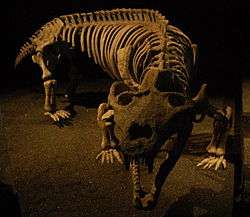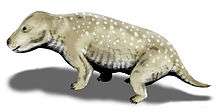Exaeretodon
| Exaeretodon Temporal range: Middle Triassic–Late Triassic | |
|---|---|
 | |
| Exhibit at Mori Tower | |
| Scientific classification | |
| Kingdom: | Animalia |
| Phylum: | Chordata |
| Order: | Therapsida |
| Suborder: | Cynodontia |
| Family: | †Traversodontidae |
| Subfamily: | †Gomphodontosuchinae |
| Genus: | †Exaeretodon Cabrera, 1943 |
| Species | |
| |
| Synonyms | |
| |
Exaeretodon is a genus of traversodontid cynodont; several species are known, from various formations. E. argentinus, E. frenguelli, and E. vincei are from the Carnian-age (Upper Triassic) Ischigualasto Formation of Argentina. E. major and E. riograndensis are from the Ladinian-age (Middle Triassic) portion of the Santa Maria Formation of Brazil. E. statisticae is from the Carnian-age Lower Maleri Formation of India.
Description

.jpg)
This genus was an herbivore up to 1.8 meters (5.9 feet) long, with a specialized grinding action when feeding.[1]
An analysis of the size of the bones of calves collected in Paleorrota concluded that the mother Exaeretodon had one or two calves, for one pregnancy. Another point of interest is that these cynodonts had deciduous teeth, which is a characteristic of mammals and means that babies could not chew, and required specialized parental care. Only older juveniles had permanent teeth.
Taxonomy
When he first named the species, Argentine paleontologist José Bonaparte mentioned several features that distinguish it from all other traversodontids. The tooth rows of the upper jaw are more parallel to each other in I. sudamericanus than they are in Exaeretodon, and they are also inset closer to the inside of the mouth. There are also more postcanine teeth oriented toward middle of the subtemporal fenestrae (two holes in the bottom of the skull) and ascending rama of the dentary (projections of the lower jaw that extend up to the skull). The ascending rama are also wider and taller in the I. sudamericanus specimen. The orbit or eye socket is longer than that of Exaeretodon, as are the palatine bones.[2]
Despite the differences, a 2007 study concluded that the I. sudamericanus skull represents the same species as E. argentinus. Using allometry, paleontologist Jun Liu found I. sudamericanus to be the largest known example of a growth series in E. argentinus. Thus, Ischignathus is now regarded as a junior synonym of Exaeretodon. As the animal grew, the proportions of bones changed. These differing proportions were initially seen as species-distinguishing characters, but are now regarded as natural ontogenic variation.[2]
See also
References
- ↑ Dykes, Trevor. "TRIASSIC GOMPHODONTS; Traversodontidae, an internet directory". Retrieved 2007-07-29.
- 1 2 Liu, J. (2007). "The taxonomy of the traversodontid cynodonts Exaeretodon and Ischignathus" (PDF). Revista Brasileira de Paleontologia. 10 (2): 133–136. doi:10.4072/rbp.2007.2.07.